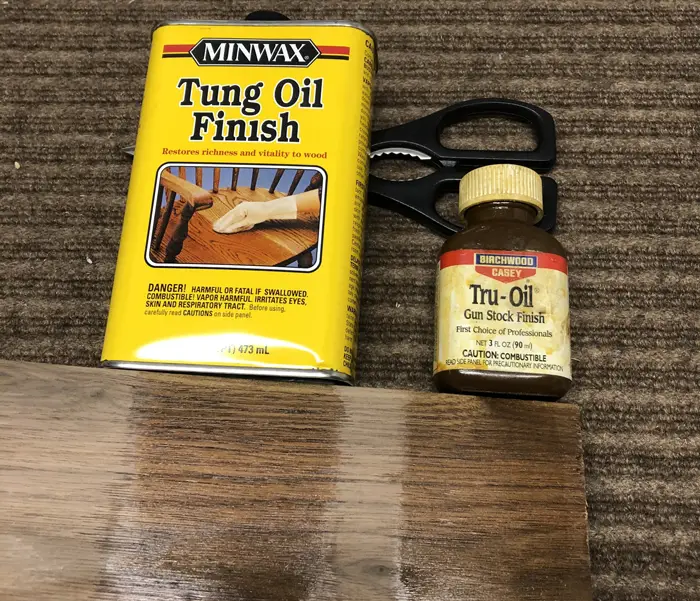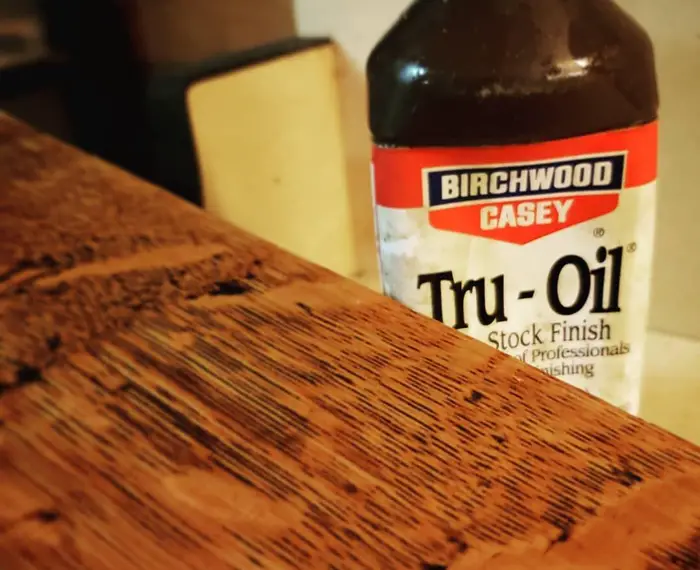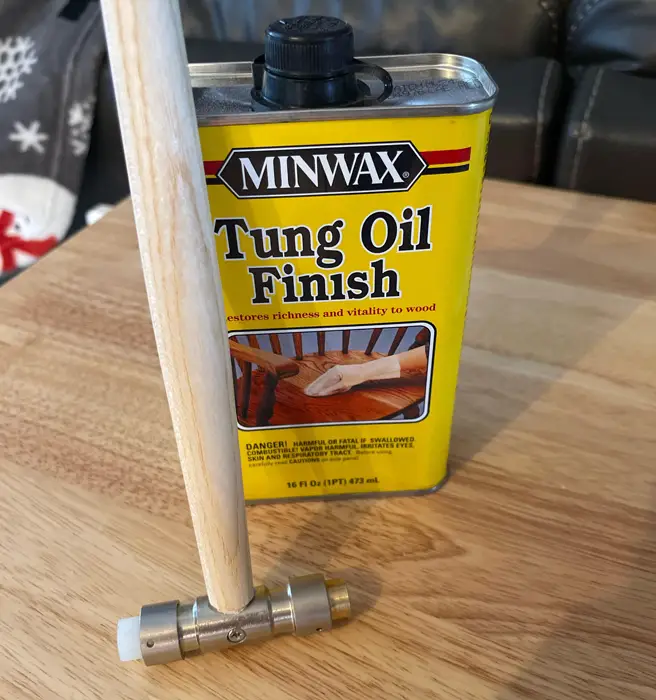Tung Oil vs Tru Oil: Which Finishing Oil Is Suitable?
Finishing is crucial in woodworking by adding a protective layer against moisture and corrosion and improving appearance. Among the finish oils used are Tung and Tru oil.
But how do Tung oil and Tru oil compare? Tung and Tru oil differ in various factors, including their sources, durability, and appearance after application. Tru oil has a milder odor than Tung oil and is usually used as a top coat. The choice of the finish to use depends on the project type.
This article aims to provide you with a detailed comparison between Tung oil and Tru oil. The information will help you make an informed decision on which one to use. So, read on.
Tung Oil Vs. Tru Oil Comparison Table

The following table compares Tung and Tru oil based on various factors. Before an in-depth comparison, look at the table for a quick overview of their basic differences.
| Factors | Tung Oil | Tru Oil |
|---|---|---|
| Source | Nut seed of Vernicia fordii (Tung tree) | Mixtures of thinners, oil varnish, and oils |
| Appearance | Matte | Glossy |
| Durability | Resistant to water and scratches | Resistant to chemicals and solvents |
| Application | Thin coats | Thicker coats |
| Odor | Stronger odor during application | Mild chemical-like odor during application |
| Purposes of Usage | Wood finishingOutdoor wood finishing | Gun stocksSmall woodworking projects |
Overview of Tung Oil
Tung oil is a drying oil from seeds in a Tung tree nut, which originates in southern parts of China and other Asian countries. The finish has been used for over ten centuries on various wooden items, including wooden furniture, concrete floors and boat decks.

While Tung trees are available in most countries, usually, major manufacturing is in China and South America. Pure Tung oil is obtained by pressing the Tung tree nut’s seed. There are no additives and distillates added. However, to improve drying time and penetration, some versions contain additives.
Tung oil makes the wood’s grains pop by seeping into them and improving their appearance. This finish is easy to apply and works on many types of wood, giving them an appealing aesthetic look.
Overview of Tru Oil
Tru oil is a brand name for a finish popularly used as a gun stock finish. This oil is manufactured by Birchwood Casey, a company that manufactures gun care products and sporting goods.
The oil is made by mixing linseed or Tung oil, thinners, and oil varnish, which are then polymerized to mix better. The result is a clear varnish that is easy to spread on the wooden item for a glossy finish.

Tru oil is usually used as the top coat on various wooden items that require a glossy finish, including musical instruments and gun stocks.. The oil can be used alone or by adding an undercoat first, then adding it as a top coat.
Tung Oil Vs. Tru Oil: Side-By-Side Comparison
As mentioned earlier, Tung and Tru oil are unique finishes based on various factors. The following section compares the two finishes based on various factors.

1. Source
Tung and Tru oil differ in source, with one having a natural background while the other a synthetic one. As mentioned earlier, Tung comes from the Tung tree, which is a natural source.
On the other hand, Tru oil is made by mixing various natural oils with thinners and other things before being cooked.
2. Appearance After Application
The final finish that the two offers also differs. Tru oil gives a glossy finish due to the use of varnish and other oils used in its making.
Tung gives the wooden item a warm, natural look and enhances its appearance with a matte finish. It dries, forming a gold or honey-ish color on the object. However, variations, like the dark Tung oil, with added non-carcinogenic hydrocarbon, give the oil a darker finish.

3. Application Process
Tung and Tru oil almost share the same characteristics in the application process. They are both applied in coats for faster drying and better results in the final product.
However, Tung oil is applied in thinner coats, which dry fast. As a result, you can re-apply another coat without waiting for a long time. On the other hand, Tru oil is usually in thicker coats and then left to dry before reapplying.
4. Durability
Tung and Tru oil are both fairly durable finishes. Tung oil seeps into the wood and dries before the next coats are added, forming a tough and resilient finish. The finish resists scratches, stains, and wear on the items better.
On the other hand, Tru oil is resistant to chemicals and solvents. It’s also fairly resistant to water damage and scratches, though it requires frequent reapplication of the cover.
5. Price
In terms of price, Tung oil is usually more expensive since its manufacturing process can be labor intensive. On the other hand, Tru oil’s manufacturing process is easy, which makes its price fairer than that of its counterpart.
Usually, 32 fluid ounces of Tung oil costs more than $43 while the same amount of Tru oil is usually below $40. However, the price varies with brand, amount, and quality.
6. Protection
One of the reasons the woodworkers use finish is to protect the wooden item from various types of damage. Impact and abrasion are some of the risks that can damage wooden items.
Tru oil, which is glossier, offers better protection against abrasion and impact on the wooden item. This fact is because it forms a hard and glossy cover on the item, protecting it from physical damage.
Which Finishing Should I Use Between Tung and Tru Oil?
Tung and Tru oils are great finishing oils that can provide the various services one looks for in a finish. Therefore, the choice of finishing oil to use in your project can be determined by various factors. They include

1. Personal Preference
Your preferred look on the item you’re working on is among the crucial determining factors. Choose Tru oil if you are after a glossy finish that will give your wooden item a shiny surface.
However, use Tung oil to maintain the wood color with an additional natural-looking finish.
2. Project Type
The nature of the project you’re undertaking can also aid in decision-making. In a project where you are building a wooden object to be placed in a high-traffic location, use Tung oil.
For a wooden object that will be exposed to chemicals and solvents, use Tru oil, which.
3. Drying Time
You can also base your decision on the drying time, especially if time is of the essence in your project. As stated earlier, Tru oil dries faster, allowing you to apply several layers daily. Choose Tru oil in this case since it will help you to complete the project faster.
However, you can improve drying time by increasing the temperature or lowering the humidity in a room and still use Tung oil.
4. Odor
Tung usually has a strong scent when it’s wet, mostly due to the oleic and linoleic acid in it. These smells can be unpleasant to most people, who sometimes find it hard to tolerate.

Tru oil has a mild chemical-like odor that is not usually unpleasant or strong. Consider using Tru oil if you have odor sensitivities and are comfortable with other factors.
5. Ease of Application
Another determining factor when choosing the finishing oil to use between the two is the difficulties during application. Usually, Tung oil is easy to apply, and you can use a brush or foam applicator. However, since it’s thin, it will require multiple coats.
Choose Tru oil, which is also easy to apply using an applicator or a brush. Since it’s thick, the coats required to reach a desired level are only a few.
When considering the best finish for your woodworking project, understanding the differences between various oils is crucial. If you’re comparing tung oil and linseed oil, it’s essential to recognize their unique characteristics and applications. Each oil offers distinct advantages, so choosing the right one can greatly affect your project’s outcome. Additionally, you might be curious about the consequences of not sanding between coats of polyurethane. Our article on not sanding between coats of polyurethane sheds light on this topic, providing valuable insights to help you achieve a flawless finish for your woodworking masterpiece.Related Questions
In this topic about Tung oil vs. Tru oil, these are the questions most people frequently ask.
Q1. Can Tru Oil Be Used Together with Tung Oil?
You can use Tung and Tru oil together on a wooden object to create a durable finish. Tung oil, which seeps into the wood, can create an undercoat. Afterward, once the Tung oil has dried, you can apply Tru oil as the upper coat in several coats.
Q2. Should I Use Tung or Tru Oil for a Rough Surface?
Tung oil usually makes a good choice for a finishing oil for a rough surface. This oil is more capable of penetrating the wood, though at the expense of more coat finish. While Tru oil is thicker, it doesn’t penetrate better and will shrink with time, requiring you to reapply it.
Q3. Does Tung Oil Cost More Than Tru Oil?
Tung and Tru oil prices vary depending on brand, quality, and quantity bought. Usually, Tung oil’s price ranges between $20 and $45, while that of Tru oil is under $40. However, remember prices may also vary with location.
Outro
Tung and Tru oil finishing oils can protect and enhance the appearance of a wooden object. However, they have differences, like in the final product’s appearance, where Tung remains matte, while Tru gets glossy.
When deciding which oil to use, it’s important to consider factors such as drying time and the type of project you’re working on. Additionally, if you have a sensitive sense of smell, it may be helpful to research the odor of each oil before deciding.





